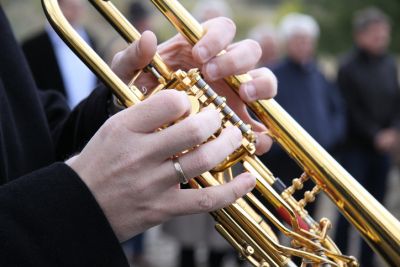 One commonality between human civilizations throughout history is the development of customs to remember and respect deceased family, friends and community members. Spiritual and cultural beliefs dictate how people bury or cremate their dead, as well as the manner in which they’re mourned and commemorated. The New Orleans jazz funeral merges African and European traditions, resulting in a community event bringing together music and people to both grieve and celebrate.
One commonality between human civilizations throughout history is the development of customs to remember and respect deceased family, friends and community members. Spiritual and cultural beliefs dictate how people bury or cremate their dead, as well as the manner in which they’re mourned and commemorated. The New Orleans jazz funeral merges African and European traditions, resulting in a community event bringing together music and people to both grieve and celebrate.
West African Practices Helped Create the Tradition
In his book “Jazz Religion, the Second Line, and Black New Orleans,” Richard Brent Turner traces some of the origins of the jazz funeral to the Yoruba people, who mostly live in modern-day Nigeria and Benin. “To the Grave and Beyond,” part of a network of West African arts and culture pages hosted on Saint Michael College’s website, details how the Yoruba prioritize the celebration of the deceased’s passage from this world into the next. Their burial should not only properly reflect their status, but also ensure that he or she becomes a revered ancestor. Additionally, New Orleans Online documented how the Dahomean and Yoruba practices of pooling resources together for funding funerals were brought to the Americas by African slaves. Black social aid clubs were formed in New Orleans to help their members with funds for medical treatment, funerals and to relieve financial hardship.
Brass Bands Set the Stage for Jazz Bands in Funerals
The inclusion of brass bands in funeral processions began in New Orleans with its European immigrants. On the Go NOLA website, writer Edward Branley documented that military bands were hired by families to accompany them on the procession from the church to the cemetery. The costs of giving family members a suitable sendoff drove the creation of benevolent societies within Irish, German and Italian immigrant communities. Like the black social aid clubs, one of the benefits of membership was the payment of final expenses.
In addition, the rise of Jim Crow laws after the Civil War had unintended consequences for local musical culture. As white musicians began mostly playing for whites-only events, their absence created opportunities for black musicians who invented new styles and techniques using traditional military songs and instrumentation. The creation of jazz in the Crescent City blossomed as bands both large and small took to the clubs as well as the streets. At the same time, these bands were hired to play in funeral processions by black social aid organizations, giving the new music form more room to develop, expand and grow.
The “Second Line” Allows Mourners to Join the Procession
Another distinct feature of the jazz funeral is the “second line.” This term refers to a group of mourners who join the procession, walking behind the musicians as they move through the streets. While the first set of songs played by the band is usually somber, the mood changes after the casket is lowered into the ground or the procession is out of sight from the church. Once this happens, people in the second line march and dance in a much more upbeat fashion. Members of black social aid clubs were frequently among the marchers, often wearing brightly colored ensembles and some carrying parasols. Nowadays, members of societies like the Sidewalk Steppers and the Lady Rollers can be seen in second lines at both jazz funerals and other parades in the city.
Giving Departed Loved Ones a Joyous Sendoff
Many funerary customs around the world blend elements of both mourning and celebration. The jazz funeral is one of these traditions, allowing for a full range of human emotional expression. Owing much to its African and European roots, it is a creation unique to New Orleans’ multicultural legacy and vibrant history.
Add Your Comment